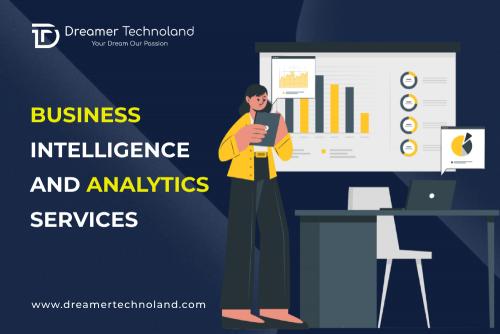A Complete Guide to Enterprise Business Intelligence

Enterprise Business Intelligence (BI) is the strategic use of data analytics to gain insights that drive better business decisions across an entire organization. Imagine transforming raw data from various departments into actionable knowledge that empowers every level of your company. That's the power of enterprise BI. In this detailed and honest blog, we will explore the power of business intelligence and analytics services and deeply understand the implementation of enterprise BI services.
What Does Enterprise BI Include?
Enterprise BI includes following things:
- Data Collection: Enterprise BI gathers data from various sources within your organization, including sales figures, customer relationship management (CRM) systems, inventory data, and marketing campaign performance metrics.
- Data Storage: The collected data is stored in a centralized data warehouse or data lake, ensuring easy access and analysis.
- Data Transformation: With business intelligence and analytics services raw data is cleaned, transformed, and integrated to ensure consistency and accuracy before analysis.
- Data Analysis: BI tools and techniques are used to analyze the data, identify trends, patterns, and correlations. This might involve data mining, reporting, online analytical processing (OLAP), and data visualization.
- Data Presentation: Insights are presented through dashboards, reports, and visualizations that are clear, concise, and easily understandable by different user groups within the organization.
Benefits of Enterprise BI
- Improved Decision Making: Data-driven insights help leaders make informed decisions at all levels, from strategic planning to marketing campaigns to operational efficiency.
- Increased Revenue and Profitability: By identifying sales trends, customer behavior patterns, and areas for cost reduction, businesses can optimize pricing strategies, target marketing efforts effectively, and improve operational efficiency, leading to increased revenue and profitability.
- Enhanced Operational Efficiency: Business intelligence consulting services provider helps identify bottlenecks and inefficiencies in processes, allowing for process optimization and improved resource allocation.
- Reduced Costs: Data-driven insights can help identify areas for cost reduction, such as minimizing waste or negotiating better deals with suppliers.
- Improved Customer Satisfaction: By understanding customer behavior and preferences through BI, businesses can personalize marketing campaigns, improve customer service experiences, and ultimately enhance customer satisfaction.
- Competitive Advantage: Data-driven businesses can gain a competitive edge by identifying and capitalizing on market opportunities faster than their competitors.
Key Components of an Enterprise BI System
- Data Warehouse or Data Lake: A central repository for storing large volumes of data from various sources.
- BI Tools and Technologies: Building custom data visualization tools offers a variety of software applications and technologies that are used for data analysis, reporting, visualization, and dashboard creation.
- ETL/ELT Tools: Extract, Transform, Load (ETL) or Extract, Load, transform (ELT) tools automate the process of moving data from various sources to the data warehouse or data lake and transforming it for analysis.
Implementation Steps for Enterprise BI:
- Define Your Business Goals: Identify the key questions you want BI to answer and how it will support your overall business objectives.
- Identify Data Sources: Pinpoint all the relevant data sources within your organization, including CRM systems, ERP systems, marketing automation platforms, and financial data.
- Choose the Right BI Tools and Technologies: Evaluate your needs and select business intelligence and analytics services and tools that offer the functionalities you require for data analysis, reporting, and visualization.
- Data Governance: Establish clear data governance policies to ensure data quality, security, and accessibility.
- Implementation and Training: Implement the BI system and provide training to employees at all levels on how to access, analyze, and interpret data.
Getting Started with Enterprise BI
- Start Small and Scale Up: Begin with a pilot project focused on a specific business challenge. Once successful, you can gradually scale up your BI implementation.
- Data Quality is Key: Prioritize data quality throughout the process. Inaccurate or incomplete data can lead to misleading insights like hospital inventory management system should be accurate.
- Focus on User Adoption: Ensure your BI system is user-friendly and accessible to all relevant employees. Provide ongoing training and support to encourage data exploration and knowledge sharing within the organization.
Summary
By implementing a well-designed enterprise BI system, you can empower your organization to make data-driven decisions, optimize operations, gain a competitive advantage, and achieve sustainable growth. Dreamer Technoland is a custom software development services provider based out of India, known for providing BI intelligence services.
Post Your Ad Here
Comments